Firewood Production Process
Firewood is made of locally supplied Spanish timber. The wood species we use to make firewood are: Ash, Oak, Birch, Alder, Pine and Fir. Each log can be cut into pieces of 25, 30 or 45 cm, split 4-6 times for 8-15 cm diameter and stacked into 1m³, 1,8m³, 2m³ or 2,2m³ boxes or bags of 9.5 L, 21 L, 30 L, 40 L or 60 Liters.
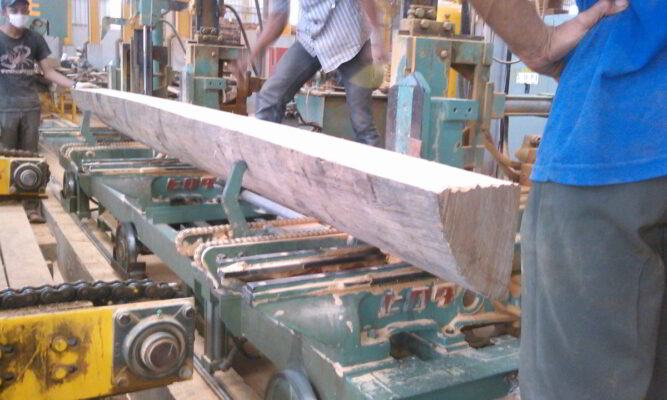
Basically, the timber has similar calorific value, only difference is the density. There are 3 categories for calorific value. This value is the energy (expressed in kcal or Kilowatts), released by burning exactly 1m³ solid timber.

Firewood calorific value groups |
||
| Firewood group | Calorific value (kcal) | Heat energy (KW) |
| Group I: Ash, Oak, Birch | 2250 – 2500 | 2,65 – 2,93 |
| Group II: Pine, Alder | 1800 – 1900 | 2,15 – 2,21 |
| Group III: Fir, Aspen | 1500 – 1700 | 1,87 – 2,10 |
On the basis of density, the firewood species have their unique features. 1st group firewood burns at highest temperature and it is most suitable for house heating in bigger boilers. For the Barbeque fireplace or Sauna, the most suitable is Birch. The 3rd group firewood is burning at relatively low temperature; therefore it is safer for smaller furnaces to protect from cracking the chimney walls.
The value of timber species, in Relation to Volume and Mass table:

Timber weight and volume ratio |
||
| timber | 1m3 weight (kg) | 1000 kg volume (m³) |
| Oak | 800 | 1,25 |
| Ash | 780 | 1,28 |
| Birch | 710 | 1,41 |
| Pine | 600 | 1,67 |
| Alder | 590 | 1,69 |
| Fir | 550 | 1,82 |
The heat value from different timber species you can calculate by comparing the heat value of solid timber and the density of timber. Example (based on average values): the 1m³ of solid Oak (Group I) timber firewood is the same as 1.71m³ solid timbers of Pine (Group II), or 2.16m³ of Fir (Group III), comparing the heat energy it generates.
Firewood is sold in 3 levels of moisture: fresh (35-55%), air-dried (25-35%) or kiln-dried (<25%).
For natural air-drying we use the yard next-to warehouse. The boxes are kept with clearance of 30 cm to ensure 360° air ventilation and quick moisture release. During the storage, each box is covered with top to protect from direct rainfall.
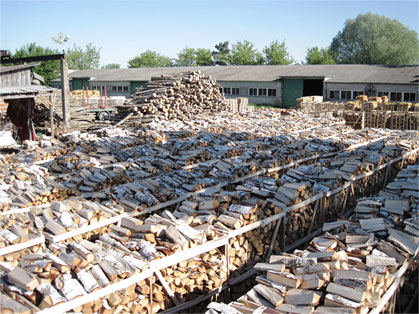
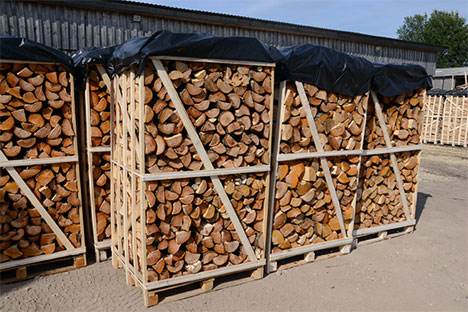
For kiln drying we rent a few drying chambers from the near-by constructional timber producers. The normal drying cycle in the kiln is 100 to 150 hours. The temperature maintained is 60° C. After the drying, the firewood is kept outside to ventilate excess vapor for minimally one day. For the moisture limit in the kiln-dried firewood, the Formula of Average Firewood Humidity is used. We take Moisture levels at:
• Outside End of log
• Inside End of log
• Inside Center of log
Then divide the sum by 3 and that is the Average Moisture of Firewood. The standard normal log has 15-20% outside moisture and ~30% in the very center inside of log.
For summer season we recommend to stock-in with Fresh firewood. This way, you will save money, because firewood timber prices are cheapest in spring. Also in 3 to 4 months the firewood gets dried naturally, so minimal or none chamber-drying is required any more. So, the drying cost is saved as well.
The packing of Firewood in Boxes
The firewood is packed into easy-access wooden boxes. If packed into bags, then the bags are stacked into boxes. Boxes are the best way to manipulate and transport firewood. The basic limitations are the weight of cargo – its 24 tons and the space inside the trailer. The volume is rarely a limitation (except for sea container) and the number of boxes depends on box size, timber species and humidity of firewood.
The different schemes for loading firewood into the truck are provided in the table:

Firewood boxes in truck |
||
| Stère / Raum meter | Fresh-cut firewood | Dried firewood |
| 2 RM (2 cubic meters) | 22-24 | 25-26 |
| 1,8 RM (1,8 cubic meter) | 25-26 | 28 |
| 1 RM (1 cubic meter) | 48-56 | 52-60 |
The volume of firewood in boxes is measured in Raumeter or Stere. 1 RM or Stere is equal to 1 m3. The typical box dimensions (measured Inside, Length x Width x Height, m):
| Box contains 1 RM = 1.17 x 0.92 x 0.93 m 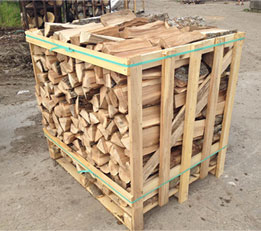 |
Box contains 1.8 RM = 1.12 x 0.8 x 2.0 m 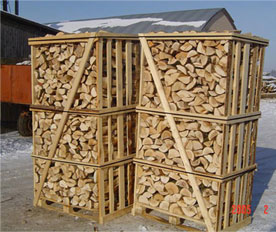 |
Box contains 2 RM = 1.13 x 0.93 x 1.9 m 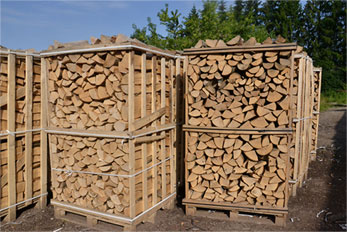 |
*+/- 2 cm tolerance due to handcraft and other factors is accepted. The dimensions of box shall be equal or very close to announced volume (i.e. 1.13×0.93×1.9=1.9967m³ is called a 2 RM box).
For the outer dimension of box (to calculate the floor space required), add 5-7 cm on each inner dimension.
To convert one Raumeter volume to solid wood volume, following coefficients are used:
On the average 1RM = 0.62-0.64 m³ of solid wood.
Coniferous trees 1RM = 0.53 – 0.68 m³; Leafy (hardwood) trees 1RM = 0.49 – 0.67 m³.
The regular log is 8 to 15 cm in diameter. The length can be 25 cm, 30 cm and 45 cm and depends onto which size (1RM, 2RM or 1,8RM) box they are stacked. The box has 1-2 rows of firewood pile on top.
The different log length determines the volume multiplier. The shorter the log, the less “empty space” there’s in the box. Hence, the 30 cm logs occupy space in box more complete than i.e. 45 cm logs. To understand the volume in Raumeter (Steremeter), as compared to solid wood volume, the table below to be used. A reference point is a 1 x 1 x 1 meter box, filled with 100 cm long logs. This box would have a multiplier of 1.

Length of logs and volume in a box |
|
| Log length: | Multiplier coefficient |
| 50 cm | 1.25 |
| 45 cm | 1.30 |
| 30 cm | 1.52 |
| 33 cm | 1.43 |
| 25 cm | 1.67 |
Example: if you have 2m³ of firewood, cut into 100 cm logs, it would occupy exactly 2 RM. If you have a 2m³ box with 30 cm logs inside, it equals to 3.04 m³ of solid wood. If 2m³ of solid firewood are cut into 25 cm logs, the space occupied then equals 2 m³ X 1.67 = 3.34 RM. Simply – the shorter the logs are, the more “solid” timber the same size box contains. Most popular length is 30 cm.

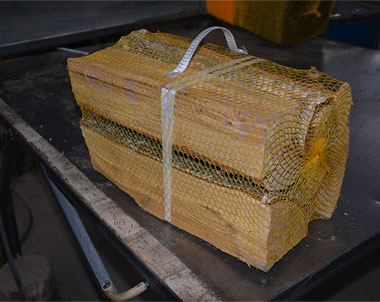
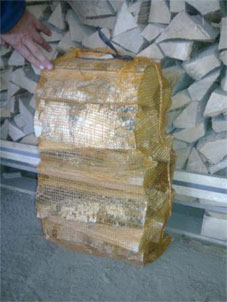
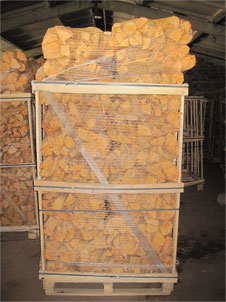
For the production in bags, Biomasa Forestal SL specializes in 40 L bag production. Standard-conforming bag is 50 x 72 cm and weighs 14.5 -15.5 kg for Kiln dried firewood. Other popular sizes are 21 L or 60 L. Another popular product is the kindling sticks. The fire starters (kindling sticks) are 10-12 cm long ~2cm diameter tiny pieces of dry firewood (the humidity 10-15%). The sticks are packed into 9.5 Liter (3 – 3.5 kg) or into 30 L (5 – 5.5 kg) bags. Bags are stacked onto pallets. The 9.5 L bags are packed onto ~1m³ box (96 bags per pallet); the 30 L bags are stacked into 2m³ boxes (78 bags).
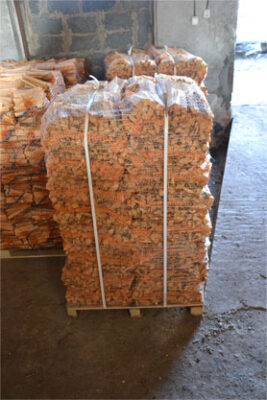

Firewood Quality management
The most important for firewood are obviously the box quality and residual moisture (if it is dried). Ideal firewood box has strong side boards and well attached straps to endure the transfer and loading works.
The side boards must be ~5 cm width and correct rectangular shape. The 3 sides of the box are closed, the frontal part open for convenient access of logs. The box should have at least 2 straps around between top and bottom. The logs must be split at least into half, mostly in 4 or 6 pieces diagonally. The box shall contain only the firewood logs (no timber remaining or waste wood). Logs have to be mold-free.
The moisture of firewood measurement rule: because there is no way to dry the whole log equally, one must refer to the average of the moisture level. The applied rule is fully quoted below.
“Firewood humidity measurement method: an average size firewood log (from center of box) shall be split and left for 30 min indoor to evaporate. Then 3 measures shall be taken: a) center of outer side of log, b) end of log, b) center of split log inner side. The average of 3 measures is the humidity content. Dry firewood is considered to be of no more than 25% humidity content, unless agreed other. No limits apply for fresh firewood humidity content.”
Warehousing of firewood: the key steps, to avoid problems with firewood, are: 1. Protect from moisture absorption, 2. Protect from direct rain and 3. Protect from mold formation in poor ventilation. The best place to keep the firewood is outside in the open wind under cover/roof. This way it gets good ventilation and there’s no potential for mold to grow. Other option is in a warehouse if one can make sure the firewood gets sufficient 360° ventilation.
When the fresh firewood is stored outside, it would dry faster if there’s direct sunlight. In such case we recommend to cover the boxes with the plastic transparent tops to protect from rain.
The birch is very special type of firewood. Thanks to its good burning features and pleasant odor, it is most appreciated in Norway, Malta and in number of other countries as well. Birch is not only valuable heating fuel, but also perfect to use in private and business for Pizza Ovens, Steak Grill etc., picnics, camping, Sauna and so forth. For dry birch firewood, packed in bags, the Norsk Standard 4414 – special requirements for quality – is applied:
NS4414 Standard requirements for the dry birch firewood.
 |
NS4414 (Norsk Standard 4414) requirements |
|||
| Class I | Class II | Class III | Class IV | |
| Species | Selected Birch | Hardwood: birch, oak, ash, maple, rowan | All species | All species, incl. sapwood & demolition wood |
| Cannot be mixed | Cannot be mixed | Can be mixed | Can be mixed | |
| Allowance for fast decay | Not tolerated | Up to 10% of logs | Up to 15% of logs | maximum 10% may have loose rot |
| Size of largest log | Min 8 cm Max15 cm |
Min 4 cm / Max 18 cm Max 20% of logs <8cm or >15 cm |
Min 4 cm / Max 18 cm. Max 20% of logs <8cm or >15 cm |
Max 18 cm |
| Splitting | All logs are split | 90% logs are split | Round logs max 8cm diameter allowed | Not required for logs <18 cm |
| Lengths acceptable | 20 cm – 30 cm – 60 cm – 300 cm | |||
| Lengths deviation | +/- 1 cm | +/- 2 cm | +/- 10% | +/- 10% |
| Humidity | Max 20% | Max 22% | Max 25% | Max 25% |